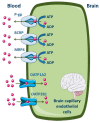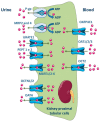Cellular Models and In Vitro Assays for the Screening of modulators of P-gp, MRP1 and BCRP
- PMID: 28397762
- PMCID: PMC6153761
- DOI: 10.3390/molecules22040600
Cellular Models and In Vitro Assays for the Screening of modulators of P-gp, MRP1 and BCRP
Abstract
Adenosine triphosphate (ATP)-binding cassette (ABC) transporters are highly expressed in tumor cells, as well as in organs involved in absorption and secretion processes, mediating the ATP-dependent efflux of compounds, both endogenous substances and xenobiotics, including drugs. Their expression and activity levels are modulated by the presence of inhibitors, inducers and/or activators. In vitro, ex vivo and in vivo studies with both known and newly synthesized P-glycoprotein (P-gp) inducers and/or activators have shown the usefulness of these transport mechanisms in reducing the systemic exposure and specific tissue access of potentially harmful compounds. This article focuses on the main ABC transporters involved in multidrug resistance [P-gp, multidrug resistance-associated protein 1 (MRP1) and breast cancer resistance protein (BCRP)] expressed in tissues of toxicological relevance, such as the blood-brain barrier, cardiovascular system, liver, kidney and intestine. Moreover, it provides a review of the available cellular models, in vitro and ex vivo assays for the screening and selection of safe and specific inducers and activators of these membrane transporters. The available cellular models and in vitro assays have been proposed as high throughput and low-cost alternatives to excessive animal testing, allowing the evaluation of a large number of compounds.
Keywords: ATP-binding cassette transporters; P-glycoprotein; activators; breast cancer resistance protein; cell-based assays; cellular models; in vitro assays; inducers; membrane assays; multidrug resistance-associated protein 1.
Conflict of interest statement
The authors declare no conflicts of interest.
Figures







Similar articles
-
Arylamino Esters As P-Glycoprotein Modulators: SAR Studies to Establish Requirements for Potency and Selectivity.ChemMedChem. 2015 Aug;10(8):1339-43. doi: 10.1002/cmdc.201500143. Epub 2015 May 26. ChemMedChem. 2015. PMID: 26012726
-
Flavonoids inhibit breast cancer resistance protein-mediated drug resistance: transporter specificity and structure-activity relationship.Cancer Chemother Pharmacol. 2007 Nov;60(6):789-97. doi: 10.1007/s00280-007-0426-7. Epub 2007 Mar 8. Cancer Chemother Pharmacol. 2007. PMID: 17345086
-
Multidrug resistance proteins: role of P-glycoprotein, MRP1, MRP2, and BCRP (ABCG2) in tissue defense.Toxicol Appl Pharmacol. 2005 May 1;204(3):216-37. doi: 10.1016/j.taap.2004.10.012. Toxicol Appl Pharmacol. 2005. PMID: 15845415 Review.
-
Modulation of function of three ABC drug transporters, P-glycoprotein (ABCB1), mitoxantrone resistance protein (ABCG2) and multidrug resistance protein 1 (ABCC1) by tetrahydrocurcumin, a major metabolite of curcumin.Mol Cell Biochem. 2007 Feb;296(1-2):85-95. doi: 10.1007/s11010-006-9302-8. Epub 2006 Sep 8. Mol Cell Biochem. 2007. PMID: 16960658
-
ABC transporters during epilepsy and mechanisms underlying multidrug resistance in refractory epilepsy.Epilepsia. 2007;48 Suppl 5:140-9. doi: 10.1111/j.1528-1167.2007.01302.x. Epilepsia. 2007. PMID: 17910594 Review.
Cited by
-
Heparin and Heparin-Based Drug Delivery Systems: Pleiotropic Molecular Effects at Multiple Drug Resistance of Osteosarcoma and Immune Cells.Pharmaceutics. 2022 Oct 13;14(10):2181. doi: 10.3390/pharmaceutics14102181. Pharmaceutics. 2022. PMID: 36297616 Free PMC article. Review.
-
Clinically-Relevant ABC Transporter for Anti-Cancer Drug Resistance.Front Pharmacol. 2021 Apr 19;12:648407. doi: 10.3389/fphar.2021.648407. eCollection 2021. Front Pharmacol. 2021. PMID: 33953682 Free PMC article. Review.
-
Molecular and pharmacological aspects of piperine as a potential molecule for disease prevention and management: evidence from clinical trials.Beni Suef Univ J Basic Appl Sci. 2022;11(1):16. doi: 10.1186/s43088-022-00196-1. Epub 2022 Jan 28. Beni Suef Univ J Basic Appl Sci. 2022. PMID: 35127957 Free PMC article. Review.
-
Dysfunction of ABC Transporters at the Surface of BBB: Potential Implications in Intractable Epilepsy and Applications of Nanotechnology Enabled Drug Delivery.Curr Drug Metab. 2022;23(9):735-756. doi: 10.2174/1389200223666220817115003. Curr Drug Metab. 2022. PMID: 35980054 Review.
-
Binding mode analysis of ABCA7 for the prediction of novel Alzheimer's disease therapeutics.Comput Struct Biotechnol J. 2021 Nov 27;19:6490-6504. doi: 10.1016/j.csbj.2021.11.035. eCollection 2021. Comput Struct Biotechnol J. 2021. PMID: 34976306 Free PMC article.
References
-
- Hesselson S.E., Matsson P., Shima J.E., Fukushima H., Yee S.W., Kobayashi Y., Gow J.M., Ha C., Ma B., Poon A., et al. Genetic variation in the proximal promoter of ABC and SLC superfamilies: Liver and kidney specific expression and promoter activity predict variation. PLoS ONE. 2009;4:e6942. doi: 10.1371/journal.pone.0006942. - DOI - PMC - PubMed
Publication types
MeSH terms
Substances
LinkOut - more resources
Full Text Sources
Other Literature Sources
Research Materials
Miscellaneous

